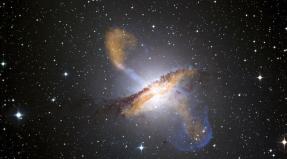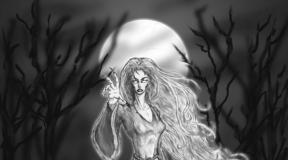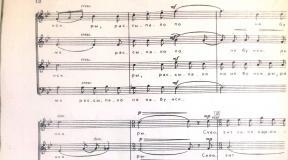How consciousness is related to the functioning of the brain. Consciousness and the brain: can one exist without the other
Man has been given a gift - reason and flight of ideas. Objects and phenomena that live on the edge of the spiritual world. Theologians are promoting the idea of a divine spark of higher intelligence. Idealists claim that reason is primary and given to people for self-study. Materialists and psychologists recognize the mind as a function of brain activity that reflects the world.
Almost no one argues anymore that there is a direct relationship between the awareness of being and the work of the brain. A huge number of scientific disciplines are studying the nature of these phenomena: psychophysiology, psychology, medicine and others. Philosophy has been no exception for many millennia. Philosophical analysis is to understand the essence of the origin and possibilities of consciousness and the brain during the transformation of the reality in which we live.
People actively cognize objective reality and their being from birth, through psychic phenomena and functions given by nature. Relationships are born only through communication with other people through speech. This is characteristic only of a person, and only if he lives in a society.
Millions of years passed before a man with a mind appeared. All thanks to the unique property of the psyche to reflect. Reflection is the property of any system to change when interacting with something. Where are the roots, the beginning of consciousness?
It all starts in the brain
 The human brain is a subtle device that is part of the whole organism and at the same time autonomously. It is the brain that is the organ that gives birth to consciousness, philosophy claims.
The human brain is a subtle device that is part of the whole organism and at the same time autonomously. It is the brain that is the organ that gives birth to consciousness, philosophy claims.
Initially, doctors, later scientists noticed and confirmed with a mass of examples and experiments that all reactions in humans are observed if there is a normal functioning of the brain, the main organ of the central nervous system. It is the healthy brain matter that gives the normal functioning of the entire psyche. Pleasure, laughter, tears, pain and much more are inaccessible to those who have disturbed or affected parts of it.
An injury to the frontal lobe makes it impossible to perform mental actions. The cerebral structures of the occipital part are disrupted, there is a loss of spatial orientation. Frontal lobes are damaged, complex behavioral programs become inaccessible. There are many similar examples.
Child consciousness goes through all the stages of growing up along with the development of the brain. At the same time, the old man's brain already demonstrates some loss of the functionality of the mind. The more complex the structure of the brain of a living being, the more diverse and subtle the reactions. The more original reality is reflected.
Consciousness and language
It is impossible to separate, even temporarily, a thought from the matter that lathers it. The brain is the material substrate of consciousness. He processes all the information received with logical algorithms, translating it into signs, words make up speech. Language is the basis for thinking.
The means of communication between people is the word. Language acts as a way to formulate, express one's thought and convey it to others as a result of mental operations and awareness of what is happening. Thought speech known oral, written and internal (thoughts about oneself). Her birth takes place in the same place, in the brain.
Only if there is a second signaling system, we understand that a person has consciousness. Without consciousness there is no speech, without speech there are no signs of consciousness. This is their unity and mutual existence. Language allows you to move from perception and representations to the formation of whole concepts. However, there is no need to talk about the identity of these two phenomena, even in philosophy. Consciousness reflects the world, and language denotes and expresses thought.
Consciousness as a philosophical phenomenon
 The most difficult and controversial topic in philosophy is the one that tries to answer the question "What is consciousness?" It is known that this is the highest form of reflection of reality, inherent exclusively to human beings on the planet.
The most difficult and controversial topic in philosophy is the one that tries to answer the question "What is consciousness?" It is known that this is the highest form of reflection of reality, inherent exclusively to human beings on the planet.
The very problem of the relationship between the brain and the mind lives on the border of philosophy and scientific disciplines. Philosophy considers it through the prism of three facets: dualism, idealism and materialism.
Ancient thinkers looked at consciousness as at the moment of getting various signals from the senses and their further analysis, comparison, processing.
In the Middle Ages, this concept was endowed by philosophers with a supra-world principle (divine) that existed before nature.
In the philosophy of modern times, it appears as a self-contained subjectivity, a special ideal matter.
In one of the non-classical philosophical approaches, consciousness is the subjectivity of being, in which the being of thinking is important, and not thinking about being.
Consciousness and unconscious
 Psychoanalysis added to awareness the concept of the unconscious, symbolizing the experience of previous generations in the psyche of the individual. Often people trust the unconscious more than consciousness, especially when no logical solution is found.
Psychoanalysis added to awareness the concept of the unconscious, symbolizing the experience of previous generations in the psyche of the individual. Often people trust the unconscious more than consciousness, especially when no logical solution is found.
The unconscious is manifested and realized. Memory, motivation, thinking, interest, need, which is in the unconscious, "materialize" in dreams, dreams, involuntary actions, art and creativity, erroneous actions, slips of the tongue, slip of the tongue. The philosophical task is to find harmony between these two phenomena in order to achieve a state of happiness and keep it.
So, consciousness has received an independent status of existence. Whoever of the scientists studies, they note that it unites all mental processes and functions:
- receiving, interpreting and accumulating information and impressions;
- integration of experience, determination of its significance;
- formation of an attitude towards the world, determination of one's place;
- design, forecasting and regulation of their activities.
Consciousness in life is manifested in a sensory form (sensations, perceptions, representations) and in a rational (concepts, judgments, inferences). Attention, emotions, memory, will, thinking are its components.
A new round in the study of consciousness and the revision of the postulates in philosophy itself happened in connection with the development of artificial intelligence in recent years. The creation of programs that understand the language, combined the natural-scientific and humanitarian approaches, solved psychophysiological problems through the analysis of this phenomenon.
Its structure and components are still being studied by philosophers today, as modern research continues to highlight new elements. Functionalists argue the analogy between the computer and the functioning of the brain. Computer research, engineering linguistics, and the theory of artificial intelligence give rise to other components of consciousness: cognitive schema, cognitive map, frame, and others.
There are important differences between the human psyche and various even the most developed representatives on earth: self-awareness, introspection and self-control. Only a person is able to distinguish himself from the environment and express himself. Only he is inherent in intuition, inspiration, insight, reflection.
Currently, the most actively developing approaches in the science of studying consciousness and the brain are:
- - neuropsychological, in which the functions of the mind depend on specific areas of the cerebral cortex;
- - neurochemical, which studies the effect on consciousness of mood, alcohol, drugs, changing the chemistry of brain matter;
- - neurocybernetic, in it the consciousness and the brain are information systems with complex programs and algorithms.
Consciousness is special type of information, therefore, consider the relationship between the carrier of this information and the information itself. It is embodied in codes, that is, in images, and arising in the cerebral nerve connections, the image is encoded. Any information is both content and value and a factor of management.
Philosophy and space
 Philosophers allowed themselves to approach the concept from different sides, different from natural scientists. Their inquisitive mind noticed human attempts to master the language of the cosmos, to understand its info-structures. Now it is clear that man, with his consciousness and unconsciousness, is also associated with cosmic processes.
Philosophers allowed themselves to approach the concept from different sides, different from natural scientists. Their inquisitive mind noticed human attempts to master the language of the cosmos, to understand its info-structures. Now it is clear that man, with his consciousness and unconsciousness, is also associated with cosmic processes.
The complete interconnection of consciousness, the unconscious and the cosmic poured out into a whole theory of telepathy, clairvoyance, about the connection between space and time. The doctrine of hypnosis is successfully implemented in medicine. This was the impetus for the development of science on the problem of "Consciousness and the Brain".
And all this is due to the human brain and all the processes that it is aware of and in it. So one can do some conclusions about consciousness and the brain:
- it refers to the highest form of reflection of reality and is peculiar only to man, like articulate speech;
- knowledge is its core;
- the mind is formed only if there is a society and organized activity or labor;
- the brain is a complex material and physiological system, one of its functions is consciousness;
- it is simultaneously multicomponent in its structure and integral;
- it is active and has the ability and ability to influence the world around it.
Send your good work in the knowledge base is simple. Use the form below
Students, graduate students, young scientists who use the knowledge base in their studies and work will be very grateful to you.
Posted on http://allbest.ru
MINISTRY OF EDUCATION AND SCIENCE OF THE RUSSIAN FEDERATION
FEDERAL STATE BUDGETARY EDUCATIONAL INSTITUTION OF HIGHER PROFESSIONAL EDUCATION "TYUMEN INSITUTE OF STATE AND LAW"
DEPARTMENT OF CIVIL LEGAL DISCIPLINE
TEST
Consciousness and human brain
Completed
1st year full-time student
I.A. Ivanov
Checked
Ph. D., associate professor of the department
A.S. Grigoriev
Nizhnevartovsk, 2014
Introduction
The psychophysiological problem is one of the points of contact of philosophy with a group of special sciences and, first of all, with the physiology of the higher nervous activity of animals and humans and human psychology. The key to solving the psychophysiological problem lies in the depths of philosophical science, since philosophy performs special ideological and methodological functions, which by themselves cannot be performed either by individual special sciences or by the totality of specific scientific knowledge as a whole.
The relevance of the chosen topic of the test is due to the special importance of the psychophysiological problem for solving one of the main questions of philosophy - about the essence of consciousness. The psychophysiological problem is one of the main components of the question of the relationship between consciousness and the brain.
The history of the concepts of the relationship between mental and physiological processes is a consistent movement towards understanding the essence of the problem and contains a number of valuable guesses. Having received a deep development in the XX century, the psychophysiological problem still does not have a generally recognized solution and is one of the most important problems of philosophy.
The nature and state of the solution of the psychophysiological problem have always been closely associated with the development of psychology and physiology. The psychophysiological problem arises initially in a pre-scientific (mythological, religious) form in the form of a problem of the soul and body, and in the 17th-18th centuries it becomes a problem of emerging physiology and psychology.
The purpose of the work is to find out the state of development of a psychophysiological problem in modern psychophysiology and philosophy, its philosophical foundations in domestic and foreign science, to determine the main directions of further development of the problem. This goal defines the following tasks:
1. to study the problems of consciousness in philosophy to identify the relationship in the pair of consciousness - the brain;
2. to analyze the development of psychophysiological problems in modern scientific literature;
3. to explore the basic psychophysiological concepts of consciousness and give descriptions of their philosophical content.
philosophical consciousness brain substance
1. Consciousness and the brain
1.1 Problems of consciousness in philosophy
Consciousness has always attracted the close attention of philosophers, for determining the place and role of a person in the world, the specifics of his relationship with the surrounding reality, presupposes the clarification of the nature of human consciousness by analyzing consciousness as a specifically human form of regulation and control of human interaction with reality. This form is characterized, first of all, by the allocation of a person as a kind of reality, as a bearer of special ways of interacting with the outside world, including managing it.
This understanding of the nature of consciousness presupposes a very wide range of issues, which becomes the subject of research not only in philosophy, but also in special humanities and natural sciences: sociology, psychology, linguistics, pedagogy, physiology of higher nervous activity, and now also semiotics, cybernetics, informatics. Consideration of certain aspects of consciousness within the framework of these disciplines is always based on a certain philosophical and worldview position in the interpretation of consciousness. On the other hand, the development of special scientific research stimulates the development and deepening of the actual philosophical problems of consciousness. Sharp and topical issues of modern social development, the interaction of man and technology, the relationship between scientific and technological progress and nature, the problems of education, communication of people, etc. - all the problems of modern social practice turn out to be organically connected with the study of consciousness.
The most important philosophical question has always been and remains the question of the relationship of a person's consciousness to his being, about the involvement of a person with consciousness in the world, about the possibilities that consciousness provides to a person, and about the responsibility that consciousness imposes on a person.
A person's being in the world is always associated with consciousness, "permeated" by it. There is no human existence without consciousness, regardless of one or another of its forms. It is another matter that the real being of a person, his relationship with the surrounding social and natural reality act as a wider system, within which consciousness is a specific condition, means, prerequisite, "mechanism" for inscribing a person into this integral system of being. Thus, if we proceed from the understanding of human reality as a whole, then the secondary nature of consciousness in relation to human being appears as a secondary element in relation to the system that encloses it and includes it. In this sense, a person's being constantly goes beyond the limits of consciousness as an ideal plan, a program of action, it turns out to be richer than the content of the initial representations of consciousness. At the same time, this expansion of the "existential horizon" is carried out in activities stimulated and directed by consciousness.
If we proceed from the organic involvement of man in the integrity of inanimate and living nature, then consciousness acts as a property of highly organized matter. Hence, it becomes necessary to trace the genetic origins of consciousness in those forms of organization of matter that precede man in the process of his evolution. The most important prerequisite for such an approach is the analysis of the types of attitude of living beings to the environment, within the framework of which the corresponding regulators of behavior emerge as their "serving mechanisms". The development of the latter presupposes the formation of bodily organs, thanks to which the processes of the psyche and consciousness are carried out. We are talking about the nervous system and its most highly organized division - the brain. However, the determining factor in the development of these bodily organs is the real vital function for which these organs work. A person is conscious with the help of the brain, but consciousness is not a function of the brain itself, but a function of a certain, specific type of relationship of a socially developed person with the world.
If this premise is taken into account, then consciousness from the very beginning is a social product. It arises and develops in the joint activities of people, in the process of their work and communication. By being involved in these processes, people develop appropriate ideas, attitudes, norms, which, together with their emotional coloring, constitute the content of consciousness as a specific form of reflection. This content is fixed in their individual psyche.
Consciousness in the broad sense of the word, of course, should also be associated with the idea of self-awareness. The development of complex forms of self-consciousness occurs at rather late stages in the history of human consciousness, where self-consciousness acquires a certain independence. However, its origin can be understood only on the basis of considering the essence of consciousness as a whole.
Consciousness, therefore, acts as a key, initial philosophical concept for the analysis of all forms of manifestation of the spiritual and mental life of a person in their unity and integrity, as well as ways of controlling and regulating his relationship with reality, managing these relationships.
1.2 The relationship between the brain and consciousness
Interest in the relationship between consciousness and the brain has arisen for a long time. For Russian physiology, starting from the time of I.M. Sechenov and I.P. Pavlova, it is traditional to a certain extent. However, for a long time, the solution of such a complex problem was considered a matter of the distant future. The understanding that the study of the problem of consciousness is an urgent task of today came to physiologists relatively recently: the rapid progress of brain science brought this topic to the front pages of journals on neuroscience. The breakthrough in this area was largely associated with the emergence of techniques for "imaging a living brain", such as positron emission tomography, functional magnetic resonance and multichannel recording of electrical and magnetic fields of the brain. The latest devices made it possible to see on the display screen which zones are activated when performing various tasks that require mental exertion, and also to determine with great accuracy the localization of lesions in diseases of the nervous system. Scientists have gained the ability to obtain the corresponding images in the form of colorful brain maps.
A feature of the human psyche is the awareness of many processes of his inner life. Consciousness is a function of the human brain. The evolutionary-epistemological interpretation of consciousness can be supplemented with a neurophysiological component, which makes it possible to define this phenomenon as a way of existence of neural systems, in the process of which the relative arbitrariness of the reactions (degrees of freedom) of individual neurons and / or their complexes is maintained, reflecting the arbitrariness of the external (in relation to the nervous system ) environment. Most researchers are supporters of the verbal theory of consciousness. They talk about the decisive role of speech activity in the phenomenon of consciousness. These views are supported by neurophysiological data. The absence of a verbal account of the conditioned reaction means a lack of awareness of it. For the awareness of any external stimulus, activation of connections between the perceiving area of the cerebral cortex and the motor speech area is of decisive importance. The optimal conditions for conscious perception are provided by the inclusion of the mechanism of selective attention. Selectivity of attention is provided due to the fact that although unnecessary information is perceived, then the transmission of information to the structures of the hippocampus is blocked. Thus, the idea of the important role of memory in the emergence of subjective experience receives additional confirmation in studies of attention.
G.V. Gershuni described the so-called sub-sensory zone, i.e. the zone of subthreshold stimuli, to which conditioned reflexes can be developed, but which, however, will not be realized by the subject. Thus, at an unconscious level, conditioned reflex activity is possible, although in a rather narrow zone, near subjective thresholds. The discovery of the functional asymmetry of the brain emphasizes the connection between consciousness and the functions of the dominant speech hemisphere. The representation of speech function in humans is asymmetric. It is located in the left hemisphere. This phenomenon is called functional asymmetry. Asymmetry is characteristic not only for speech, but also for other mental functions. Today it is known that the left hemisphere in its work acts as the leading one in the implementation of speech and other functions related to speech. The right hemisphere performs non-speech functions, and the corresponding processes usually proceed at the sensory level. It should also be emphasized that the specialization of the hemispheres occurs in the process of individual human development. The study of possible mechanisms of consciousness in connection with the functional interhemispheric asymmetry of the brain led to the idea of some interhemispheric distribution of the functions of consciousness. So, verbal consciousness is represented in the dominant (left in right-handed) hemisphere, and the feeling of "I" (self-esteem, self-awareness) - in the subdominant (right in right-handers). Therefore, right-brain lesions lead to personality disorders, and left-brain lesions lead to speech disorders.
The functions of the "interpreter" of the motives and actions of the right hemisphere are also attributed to the left hemisphere, even if these motives are unknown to him; in this case, of course, interpretations may be erroneous.
Unilateral lesions of the hemispheres lead to different impairments of consciousness in left-handers and right-handers, depending on the characteristics of their interhemispheric asymmetry. In this regard, the term "asymmetry of consciousness" is introduced. So, the defeat of the right hemisphere in right-handers is characterized by paroxysmal ignorance of the left space, the emergence of experiences of the distant past (for example, childhood); defeat of the left hemisphere leads to loss of speech and understanding, memory lapses, inappropriate actions (with subsequent amnesia), manifestations of twilight consciousness, automatic unconscious activity. Impairment of consciousness in left-handers in such situations is less differentiated, more diverse and not so rigidly associated with the side of the defeat.
In a normal state of the brain, the leading role in assessing the situation, making judgments and making decisions belongs to the dominant (more often left) hemisphere, although the subdominant hemisphere is also involved in these operations at a subconscious level.
An important property of consciousness is the ability to hold in the head the sequence of events that have occurred and arbitrarily extract them from the depths of memory.
The last decades have been marked by a breakthrough in the study of their brain mechanisms. Long-term memory is believed to be associated with the associative cortex. Along with the hippocampus, the frontal cortex plays an important role in storing the sequence of events in memory. Three groups of neurons can be distinguished in it: some react to an acting signal, others keep its trace until the moment when it is necessary to give a behavioral response, and, finally, the third include a response.
Let us summarize the ideas about the most probable mechanisms of consciousness. Comparison of newly received information with past experiences determines the content of consciousness as a constant adjustment of personal experience and what can be called the feeling of the inner "I". Consciousness is based on the idea of renewal, which gives life its highest meaning and determines a person's constant striving for novelty.
A study of the literature has shown that the question of the close connection between the brain and consciousness remains open. Scientists who hold "monistic" positions, working in neurosciences, believe that the key to unraveling the mechanisms of the psyche and behavior lies in the study of neurons, neural networks, and functional brain mapping. However, this approach is not the only one possible.
It has been scientifically proven that consciousness is always associated with the following processes occurring in the brain and does not exist apart from them:
1.consciousness is the highest form of reflection of the world and is associated with articulate speech, logical generalizations, abstract concepts, which is inherent only in man;
2. the core of consciousness, the way of its existence is knowledge;
3. labor develops consciousness;
4. speech (language) form consciousness;
5. consciousness is a function of the brain;
6. Consciousness is multicomponent, but constitutes a single whole;
7. consciousness is active and has the ability to influence the surrounding reality.
Thus, the activity of the brain and the activity of consciousness are inextricably linked.
2. Modern psychophysiological concepts
2.1 Psychophysiological problem
The first views about the soul and body arose in ancient times and were presented in views of the soul as a kind of independent entity located in the human body. The doctrine of the soul is the first form of knowledge that served as the basis for the development of ideas about the inner world of a person, spiritual, mental. On the one hand, the unity of the vital activity of our organism is provided by the genotype. But, on the other hand, it is quite obvious that a person is something more than an organism. This special kind of integrity that transcends the unity of our body is captured by the classical concept of the soul. From the posing of the problem of the relationship between the soul and the body, the psychophysiological problem actually arises, which was first described in the works of ancient Greek philosophers.
Democritus, referring to the problem of the relationship between the soul and the body, explains nature from itself "as having no beginning in time, but existing eternally." His soul is not some supermaterial substance, but a completely physical entity, a set of atoms, "round and fast moving ... like those that make up fire", possessing internal energy, it is the cause of the movement of living beings, the fiery principle in the body. The animal, unreasonable part of the soul is evenly distributed throughout the body. She is the source of mobility and vitality of the body. The philosopher argued that: "the soul is mortal and dies along with the body." “Souls ... perish. For what is born together with the body must inevitably perish with it, ”that is, the ideal was thought on a par with the material - as a single substance. Thus, a discrete picture of the world that has existed for more than two millennia was created, in which being was thought to consist of the smallest and isolated particles of matter, and the relations between these particles were considered not being itself, but only a property of material substance.
The idea of reincarnation of souls belongs to Pythagoras. The philosopher taught that the soul is immortal. He believed that everything that happens in the world is repeated over and over again after certain periods of time, and the souls of the dead after some time move into other bodies, giving them life. The main idea of the philosophy of Pythagoras was the transmigration of the human soul after death into the bodies of other creatures. His followers believed that the dust particles in the air constitute the soul, since they appear to be incessantly moving. Diogenes has air, which consists of the smallest particles, has a soul. Air is the first, the most subtle, the beginning of everything, and everything comes from it. That is why the soul is capable of movement and knowledge.
The psychophysiological problem developed further in the 17th century, thanks to R. Descartes, who put forward the theory of the division of all things into two substances (bodily and spiritual). The bodily substance has manifestations associated with signs of movement in space (breathing, nutrition, reproduction), and the spiritual is associated with the processes of thinking and manifestation of will. R. Descartes believed that higher mental processes cannot be directly derived from physiological (bodily) processes, or even more so reduced to them, so he began to look for an explanation of how these two substances exist in a person. This explanation was called psychophysical interaction and was defined by R. Descartes as follows: the body affects the soul, awakening passions in it in the form of sensory perceptions, emotions, etc., and the soul, possessing thinking and will, affects the body, forcing it to work and change your turn. R. Descartes's theory of psychophysical parallelism gave rise to the formation of psychology as an independent science.
As the theory of psychophysical parallelism developed, several more methods were put forward for solving the psychophysiological problem. One of them was proposed by T. Hobbes, who believed that there is only one substance - corporeal, or material, which is also a thinking substance. T. Hobbes believed that thinking is a derivative of bodily processes, and should be studied by observing various movements of the body and in the body. He substantiated this by the fact that thought is a subjective phenomenon, and bodily movements are objective, since they have their source in some external influence of the object on the sense organs.
G. Leibniz, trying to refute the theory of R. Descartes, put forward his own way of interaction between soul and body. According to G. Leibniz, the soul and body follow their own laws: the soul acts according to the law of final causes (for example, in accordance with the goal), and the body - according to the laws of acting causes. They cannot influence each other, but interact in harmony, since they are the essence of the same universe. Nevertheless, in this harmony, the spiritual in a certain sense dominates the body, and the body is a derivative of the soul.
B. Spinoza developed a possible solution to the psychophysiological problem in the spirit of monism, putting forward the concept that there are no two separate substances, but there is a single nature (God), which has different properties (attributes), from which it follows that consciousness and body are attributes of nature ... The position of monism affirms the unity of the world in its various manifestations (spiritual and material). Since a single substance has both the attributes of extension and thinking, B. Spinoza concluded that the more active a person is in the world, the more perfectly he acts, that is, the higher the organization of the body, the higher the spiritual consciousness.
V.M. wrote directly about the materiality of the psyche. Arkhipov: “In the XX century. science has taken a giant step forward. Natural science facts, accumulated by it, make it possible to finally solve the question of the materiality of the psyche. The work of the brain can be explained by some physiological, material factors. " Based on the work of I.P. Pavlov, who argued that a temporary nervous connection is a universal physiological phenomenon and at the same time it is a mental phenomenon, the scientist believed that the mental is identical to the nervous, and the laws of higher nervous activity are the laws of the dynamics of mental states, and a scientific analysis of the psyche can only be an analysis of the material nervous process.
I.P. Pavlov, on the other hand, put a sign of identity between the concepts of the nervous process and the physiological, not meaning that "nervous" is a broader concept than "physiological".
2.2 Psychophysiological concepts of consciousness
In modern studies of the psychophysiological problem, three main concepts can be distinguished: the concept of a "bright spot", the hypothesis of information synthesis, the concept of the communicative nature of consciousness.
The hypothesis about the connection of consciousness with a certain area of the cortex was first expressed by I.P. Pavlov. In search of an answer to the question: “what nervous processes occur in the cerebral hemispheres when we say that we are conscious of ourselves,” he suggested that consciousness is represented by the activity of the “creative” part of the cerebral cortex, which is in a state of optimal excitability, where it is easy to form conditioned reflexes and differentiation. Other areas where predominantly the maintenance of already formed reflexes occurs are associated with what is called unconscious activity. I.P. Pavlov expressed in a figurative form: “If it were possible to see through the cranium and if a place with optimal excitability shone, then we would see on a thinking conscious person how a bright spot, constantly changing in shape and size, whimsically changing outlines, moves along his cerebral hemispheres ".
The concept of a "bright spot", first expressed by I.P. Pavlov, was developed in the latest hypotheses in the form of the "searchlight theory". This concept was formulated by F. Crick, co-author of the double helix theory and Nobel laureate.
The main provisions of the "spotlight theory" are as follows. All information enters the cortex via sensory pathways through the switching nuclei in the dorsal thalamus (including the geniculate bodies adjacent to it). The excitability of these switching nuclei can be selectively changed by collaterals from the neurons of the thalamic reticular complex, which is part of its ventral section. The relationship between these parts of the thalamus is constructed in such a way that at any given moment one of the neuronal groups of the dorsal thalamus is in a state of high excitability, which significantly increases the impulse flow to the corresponding parts of the cortex, while other groups are, on the contrary, inhibited. The period of such high excitability lasts about 100 ms, and then the increased influx enters another part of the cortex. F. Crick assumes on this basis that the area of the highest impulse is at the moment, as it were, the center of attention, and thanks to the movement of the "spotlight" to other areas, it becomes possible to combine them into a single system. In this process, the synchronization of the activity of neuronal groups at the same frequency plays an important role, which also occurs due to the influence of ascending thalamic projections with a short-term modification of the activity of the corresponding synapses.
It is important that the number of neuronal groups involved in the joint activity includes neural ensembles in different areas of the cortex. Such integration, according to the author, ensures the implementation of higher mental functions. It is also assumed that several "spotlights" can operate simultaneously.
It is important that the number of neuronal groups involved in the joint activity includes neural ensembles in different areas of the cortex.
According to F. Crick, such integration ensures the implementation of higher mental functions. It is also assumed that several "spotlights" can operate simultaneously. This concept was developed primarily for processing visual signals, but the author of the concept assumes that the described scheme is common to all analyzers.
Information synthesis hypothesis. For the first time, the idea of information synthesis as the basis for the emergence of subjective experiences was put forward in the mid-70s. last century A.M. Ivanitsky on the basis of studies of the physiological mechanisms of sensations.
The idea of the re-entry of excitation into nervous structures as the basic mechanism for the emergence of subjective experience has been expressed in recent years by many authors. It was most fully developed in the works of the Nobel laureate (for the study of antibodies) J. Edelman, whose theory of consciousness has become quite widely known.
Moreover, these rear projections can connect both anatomically close and distant structures. This re-entry provides the ability to compare the previously obtained information with the changes that have occurred over the period of time from the previous re-entry.
According to J. Edelman, the emergence of subjective phenomena is based on the mechanism of re-entry of excitation into the same neuronal groups after additional processing of information in other groups or the receipt of signals from the external environment.
The main provisions of the theory of functional systems reflect the idea that the psyche arose in evolution because mental experiences contain a generalized assessment of the situation, due to which they act as important factors of behavior.
The concept of the communicative nature of consciousness was developed by P.V. Simonov. According to his definition, consciousness is knowledge that in an abstract form can be transferred to other people, which is reflected in the etymology of the word "consciousness" - "shared knowledge".
Consciousness arose in the process of evolution on the basis of the need for communication, the transfer of knowledge and the joining of efforts of highly organized members of the community, such as our ancestors. However, since the inner world of a person is hidden from an external observer, the transfer of information from one person to another can occur only through abstraction, that is, in the form of signs. Such a symbolic form of communication is speech, which is formed in the process of communication. On the basis of communication, consciousness also arises as the highest form of the mental, peculiar only to people.
The connection between consciousness and speech has been shown in studies of people coming out of a coma. In this case, speech contact with patients, which, as clinicians know, is an important sign of the return of consciousness, coincides with the formation of coherent connections between the electrical activity of the gnostic (parietotemporal) and motor-speech (lower frontal) parts of the left hemisphere.
The statement about the connection between consciousness and speech should not be taken oversimplified. This is evidenced by observation data on patients with temporary loss of speech functions, for example, as a result of cerebral stroke. After the return of speech, patients in this case, as a rule, remember all the events that occurred during the loss of speech, and can talk about them, which indicates that their consciousness is preserved during the period of illness. The way out of this contradiction, probably, lies in the fact that other functions of the frontal lobes associated with the ability to abstraction and memorizing sequences of events remain intact. The patient, therefore, could encode events in a different, non-verbal form and remember them.
Perhaps it is more correct to associate consciousness in its highest form not only with speech. We have already mentioned the connection between the frontal regions and abstract thinking. Another property of the frontal cortex also plays an important role. It has been established that its medial sections are related to the ability to build and store events in memory as sequentially unfolding in time, which is a characteristic feature of consciousness.
In memorizing the sequence of events, along with the cortex, the hippocampus is also involved, which is associated with declarative memory. On the basis of building a sequence of events, the ability to predict and plan arises, which is also one of the properties of consciousness.
Finally, according to D. Edelman and D. Tononi, the basis of "consciousness of a higher order" associated with speech is the same principle of re-entry of excitation into the fields of the frontal, temporal and parietal cortex, responsible for the performance of individual functions, with the implementation of speech centers the information received in the corresponding phonemes.
Conclusion
The problem of consciousness is clearly interdisciplinary in nature. Nevertheless, numerous data allow us to single out a special psychophysiological aspect of the problem of consciousness. Its content is the objective state of consciousness, its development under the influence of various external and internal factors and the reflection of this dynamics in the indicators of bodily functioning.
The individual consciousness of a person is inextricably linked with the material processes taking place in the human body, primarily in the central nervous system and the brain. The problem is to establish exactly what material processes, mechanisms and states of the brain underlie consciousness. The solution to this problem is fraught with great theoretical, methodological and methodological difficulties. And the main reason is that in the study of the brain mechanisms of the human psyche, there are still a number of fundamental problems that do not have even an approximate explanation.
The problem of the relationship of consciousness to the organization of the brain can be presented both as a special problem of neurosciences, and as a strictly philosophical psychophysical one. The vision of the latter in modern philosophy of consciousness is multifaceted. At least, it is not reduced to a special psychophysiological problem, the solution of which is to find a correspondence between certain neural processes in the brain and mental phenomena perceived or unconscious by the subject. The solution to the problem of the relationship between consciousness and the brain as a special psychophysiological problem is presented by such concepts as the concept of "bright spot", the concept of information synthesis and the concept of the connection between consciousness and speech.
Literature
1. Alekseev PV, Panin AV Philosophy: Textbook. - 3rd ed., Rev. and add. - M .: TK Welby, Prospect Publishing House, 2006. - 608 p.
2. Bekhtereva IP. Neurophysiological mechanisms of thinking, L., 1985, - 356s.
3. Gurevich PS .. Philosophy of man. - M .: IFRAN, 2001.- 304 p.
4. Davydov V.V. Actual aspects of the psychophysiological problem in the conditions of interaction between the analytical philosophy of consciousness and cognitive neurobiology / V.V. Davydov // Bulletin of KRAUNTS. Humanitarian sciences. - 2006. - No. 2. - S. 23-30.
5. Korneenkov S.S. Universal consciousness and psychophysiological human communications: aspects of psychophysics / S.S. Korneenkov // Bulletin of the Far Eastern Federal University. Economics and Management. 2005. - No. 2. - S. 20-24.
6. Kudryavtsev V. The creative nature of the human psyche // Questions of psychology. 1990. - No. 3. - S. 12-16.
7. Makarova Z.V. Scientific philosophy and psychophysiological problem / Z.V. Makarova // Abstract on the dissertation for the degree of candidate of philosophical sciences. - 2007 .-- 20 p.
8. Makarova ZV Psychophysiological problems in modern Western philosophy / Z.V. Makarova // Bulletin of the Tomsk State Pedagogical University. 2007. - No. 11. - S. 11-17.
9. Malyshevsky AF .. Introduction to philosophy: Textbook. allowance. / Ed. A.F. Malyshevsky. - M .: Education, 2005, - 256s
10. Fundamentals of philosophy in questions and answers. Textbook for higher educational institutions. M .: - Publishing house "Phoenix", 2007. - 351 p.
11. Seminars on philosophy: Textbook. / Ed. K.M. Nikonov. - M .: Higher school, 2001 .-- 297s.
12. Philosophy. Textbook. / Under the general editorship of G.V. Andreichenko, V.D. Gracheva - Stavropol: SSU Publishing House, 2001 .-- 245 p.
13. Philosophy in questions and answers. Textbook for universities / Ed. prof. HER. Nesmeyanov. - M .: Gardariki, 2000 .-- 351 p.
14. Philosophical Dictionary: 3rd ed., Revised. - Minsk: Book House. 2003 .-- 1280 s.
15. Frolov I.T. Introduction to Philosophy: Textbook for Higher Educational Institutions: In 2 hours / Under the hands of. I.T. Frolov. M., 2004 .-- 565 p.
Posted on Allbest.ru
...Similar documents
Relevance of the problem of human consciousness. Scientific concept of consciousness and its classification. Definition and structure of consciousness. Forms of untrue consciousness: egoism and altruism. Truly moral sphere of consciousness.
test, added 08/14/2007
Characteristics of the concept of consciousness in philosophy. The problem of consciousness as one of the most difficult and mysterious. The relationship of a person's consciousness to his being, the question of the inclusion of a person who has consciousness in the world. Individual and supra-individual consciousness.
abstract, added 05/19/2009
Analysis of the evolution of the concept of cognition, the concept of consciousness. The main provisions of the concept of reflection. The creative nature of consciousness, consciousness as a function of the brain. The historical relationship of social life and social consciousness. Properties of human consciousness.
test, added 01/25/2010
The doctrine of substance as a stable objective origin of the universe. Substantial approach to the analysis of the prerequisites of natural science thinking. Philosophical views on the problem of substance: dualism of R. Descartes, monism of B. Spinoza, pluralism of G. Leibniz.
abstract, added 11/17/2015
Concepts and definitions of consciousness and morality. The influence of consciousness and morality on a person and society. Types and varieties of consciousness and morality. Moral consciousness, its specificity and role in human life. Two-aspect and emergent theories.
abstract, added 04/28/2011
The problem of consciousness and the main question of philosophy. The problem of the origin of consciousness. The essence of reflection. The social nature of consciousness. Formation and formation of worldview culture. The structure and forms of consciousness. Creative activity of consciousness.
test, added 08/27/2012
Consciousness is the highest form of reflection of objective reality inherent in a person, a way of his relationship to the world and to himself. The origin of the category of consciousness. Consciousness as the basis of human existence. Philosophical interpretations of the problem of consciousness.
abstract, added 12/15/2008
The problem of consciousness in the history of philosophy. The relationship between consciousness and self-awareness, connection with language. Comparison of the social and the individual in the philosophy of psychology. The paradox of the phenomenon of illusory consciousness. The philosophical aspect of the conscious and unconscious.
abstract, added on 12/10/2011
Consciousness as one of the fundamental philosophical categories. Aspects of the content of this concept. The problem of the genesis of consciousness, its structure and functions. The main distinguishing features of human consciousness from the psyche of an animal. Sociocultural nature of consciousness.
abstract, added on 04/02/2012
Empirical data on the functioning of human consciousness, which until now seemed incompatible within the framework of a single epistemological approach. Antinomic existence of consciousness. General characteristics of the main spheres of consciousness. Need for love.
site- The role of the brain as a source of consciousness and thinking is questioned by the neurophysiologist, Academician of the Russian Academy of Sciences Natalia Bekhtereva. In her book “The Magic of the Brain and the Labyrinths of Life,” she writes: “Deepening in brain research, including on the basis of fundamentally new technologies that have not yet been created, can provide an answer to the question of whether there is a brain code for thinking. If the answer (final!) Is negative and what we observe is not the code of thinking proper, then the rearrangements of impulse activity, correlated with the brain zones activated during mental activity, are a kind of “code for the entry of a link into the system”. If the answer is negative, it will be necessary to revise the most general and most important positions in the problem "Brain and psyche". If nothing in the brain is connected precisely with the subtlest structure of our thinking, then what is the role of the brain in this process? Is this only the role of "territory" for some other processes that do not obey the brain laws? And what is their connection with the brain, what is their dependence on the brain substrate and its state? "
At the same time, it has been scientifically proven that consciousness is always associated with processes occurring in the brain and does not exist apart from them.
The brain is a vital organ. Even his insignificant damage can cause serious harm to a person, cause loss of consciousness, amnesia, mental disorder. At the same time, cases of severe brain damage, including congenital malformations up to the absence of a brain, have been documented in medical practice, in which, however, the person continued to live and function normally.
In medical practice, enough cases have been attested about people living without a brain, which forced us to reconsider the accepted dogmas in neurophysiology.
Practical cases
There is 16th century evidence of a boy without a brain. The boy, died 3 years later after a severe skull injury. Autopsy did not find his brain.
In the 19th century, Professor Hoofland (Germany) described and documented an amazing case in detail. He had the occasion to open the skull of a very elderly man who died of paralysis. Until the very last minutes, the patient retained his mental and physical abilities. The result led the professor to extreme confusion: instead of a brain, there were 28 grams of water in the deceased's skull.
In 1940, Dr. Augusto Iturrica, in his report at a meeting of the Bolivian Anthropological Society, spoke about a 14-year-old boy who was in his clinic with a diagnosis of a brain tumor. The patient remained conscious and sane until his death, only complaining of a severe headache. During the autopsy, the doctors were extremely amazed. The entire cerebral mass was separated from the inner cavity of the cranium and looked rotten long ago. Blood had no access to her. In other words, the boy simply didn’t have a brain. For doctors, the normal functioning of the boy's consciousness remained a mystery.
1980 year. An article was presented in the American magazine "Science" which described an interesting case no less than the previous one. A young student went to the hospital with mild discomfort. The doctor who examined the student drew attention to the excess of the norm, the volume of the head. As a result of scanning, the student, like the clerk, was found to have hydrocephalus, but his intelligence level was many times higher than the norm.
In 2002, a girl from Holland underwent a serious operation. She had her left brain hemisphere removed, which is still believed to contain speech centers. Today, the child amazes doctors with the fact that he has mastered two languages perfectly and is studying a third. Dr. Johannes Borgstein, observing the little Dutch woman, says that he has already advised his students to forget all the neurophysiological theories they are studying and will continue to study.
In 2007, a British medical journal wrote an article entitled "The Clerk's Brain". It told the absolutely fantastic story of a French clerk who sought medical help. A 44-year-old resident of Marseille had a leg pain. As a result of long examinations in order to find the cause of the disease, the doctors prescribed a tomography (brain scan), as a result of which the doctors found that the clerk did not have a brain, instead of brain cells, the bulk of his head was occupied by cerebrospinal fluid. Hydrocephalus or (dropsy of the brain) is a well-known phenomenon in medicine, but the fact that a clerk with such a disease functioned quite normally and his IQ was no different from that of a normal person amazed the doctors.
Another case, an American named Carlos Rodriguez, after an accident, lives practically without a brain. He had more than 60% of his brain removed, but this did not affect his memory and cognitive abilities.
These facts force scientists to admit the fact of the existence of consciousness independently of the brain.
The fact that consciousness exists independently of the brain is confirmed, for example, by studies conducted by Dutch physiologists under the leadership of Pim van Lommel. The results of a large-scale experiment were published in the authoritative biological English journal "The Lancet". “Consciousness exists even after the brain has ceased to function. In other words, Consciousness "lives" by itself, absolutely independently. As for the brain, it is not thinking matter at all, but an organ, like any other, performing strictly defined functions. It is very possible that thinking matter, even in principle, does not exist, ”says the head of the study, Pim van Lommel.
The emergence and development of thinking is closely related to the stages of a person's formation, his labor activity, the emergence of articulate speech and the improvement of language. It is in this that he began to differ from the animal.
Initially, communication and exchange of information took place through a combination of individual words with gestures, facial expressions, showing. Each word introduced into everyday life contained a certain generalization, a certain meaning. Words denoted both objects, processes and phenomena, as well as interrelationships, their differences. The accumulated set of words contributed to the formation of the signal system in conditioned reflex activity. People began to imagine, reproduce what they had seen, felt, and perceived from another experience. They have acquired the ability to think, think, imagine, plan, anticipate events, remember, transfer knowledge using vocabulary.
The mental reflection of reality was established for 2.5-3 million years and became a product of the development of the brain and nerve cells, which formed a kind of system. Along with the sense organs, they allowed the body to memorize the situation and find the previously traversed path to food, water, and build its own behavior.
The first to carry out experiments related to the analysis of brain activity was the founder of Russian physiology I.M.Sechenov. He established and proved that in the brain there are areas, special "centers", nervous mechanisms, from which inhibiting influences on involuntary or reflex movements of animals and people come. He called them "detention centers." He saw the initial reason for actions not in the soul as a divine gift, not in thoughts, will, as the idealists falsely declared, but in external sensory excitement, in specific conditions of life. The innovator noticed that reflexes are impossible without external stimuli, that they, acting on the sense organs, stimulate mental activity. The retention of traces in the central nervous system acted as the basis of memory, and inhibition - as a mechanism of selective orientation of behavior, the work of the brain - as a substrate of motivation. He put practice at the forefront of his thinking.
The doctrine of conditioned reflexes (the highest form of adaptation of the organism to the environment) has become a theoretical foundation for the study of higher brain functions. A new chapter in the physiology of the brain was prepared by I.P. Pavlov. Investigating the essence of "mental salivation", he discovered an interesting fact: along with the secretion of saliva in animals in response to irritation of the oral cavity with food, you can achieve a similar result to any stimulus (light, sound, etc.) if it is reinforced with subsequent feeding. Reflexes of the first kind (constant connections of the organism with the environment, which are inherited by genetic means in the form of a code, instinct), he called unconditioned, the second - conditioned, which appear on the basis of unconditioned, that is, in the process of individual life, and regulate actions in a changing situations. This made it possible to identify important patterns of nervous activity. He noticed that the formation and destruction of temporary connections, that is, conditioned reflexes, in the cortex of the cerebral hemispheres, as well as analytical skills, give animals the opportunity to navigate complex reality. External and internal stimuli coming from the main organs, muscles, bones, ligamentous apparatus, signal to the brain about favorable or unfavorable conditions for them, excite or inhibit certain areas, cause appropriate actions. Sleep is a consequence of inhibition of the cerebral cortex.
Conditioned reflexes arise from mental images. As a result, they are both a physiological phenomenon (inseparable from the reflexes of the brain), and the psychic generated by it.
In addition to the first signaling system (reactions to the direct influence of the external world), humans have developed a second signaling system - speech. Operating with various concepts is of great importance in the development of thinking. These systems are closely interconnected.
Based on the achievements of biology, physiology, psychology, materialists came to the conclusion that thinking is a function of the bodily brain, an active process of reflecting reality in ideas, concepts, judgments. With serious damage to individual parts of the brain, the psyche, orientation in space, and coordination of movement are also disturbed.
Analytical, logical thinking was preceded by less perfect forms of reflection and sensations. Things, their properties, relationships affect the senses. The resulting stimuli are transmitted through the nerve channels to the cerebral cortex. The emerging physiological processes are the material basis of sensations and perceptions. Ideal images are the results of the interaction of an object with the senses, subjective reality (conscious being), symbols, what is reflected and remained in memory. According to Karl Marx, “the ideal is nothing more than the material, transplanted into the human head and transformed in it” (vol. 23, p. 21). But the image does not possess the material properties of either the displayed object, or the nervous system and brain. The idea of any fruit has no weight, no color, no smell, no taste. Knowledge of an earthquake, volcanic eruption, tsunami cannot destroy a city. Concepts are images of objects, not themselves.
Plants react to changes in temperature, the change of day and night, seasons, amoeba and other unicellular organisms - to a food stimulus. This is a pre-psychic form of reflection, a physiological reaction. The initial form of the psyche is the ability to reflect the qualities and properties of objects through sensations. Many species of animals are capable of some rationality. To a certain extent, they have developed instincts, situational expediency in adaptive actions, which is a prerequisite for logical actions. But by emphasizing the similarities between mental activity in animals and humans, scientists distinguish it. Animals are not aware of their actions. Their logic did not work out. Only people can think abstractly, evaluate, possess consciousness. Dialectical thinking is inherent only in developed individuals.
Thinking is inextricably linked with labor and language, with the totality of accumulated terms and phrases. There are no naked thoughts, free from vocabulary. Outside images, perceptions, representations, thought is devoid of content, that is, it is absent. The language of gestures, facial expressions, pictures outside of words is not able to reflect much in a single, store and transmit information. Words allow you to exchange experience, knowledge, communicate. Each level of work organization corresponded to the degree of vocabulary replenishment, although not everyone uses it in full.
People are aware of their surroundings and what is happening with the help of the brain, in which, as is now recognized, over 100 billion nerve cells (neurons) are continuously working. Each of them exchanges information and signals with 10 thousand other cells. It is not in vain that he consumes about 20 percent of all energy obtained from food, although his mass is only 2-3 percent of body weight. Thought operations and emotional responses come from the neural codes of a number of subcortical nuclei. Quantum field structures have special abilities. Skin sensitivity (synesthesia) is a reflection of the properties of an external stimulus: sensations of touch, pressure and vibration, heat and cold, pain.
One of the main principles of the organization of mental functions is the comparison and synthesis in the brain of information about the available stimulus and information extracted from memory. But consciousness as the ability to transform the objective content of the reflected world into the subjective opinion of the individual, into the goal of life, thinking over the means and methods of achieving it is not a function of the brain itself, although it does not reveal itself in isolation from it. It contains inexhaustible possibilities, but no program of consciousness is laid down. It arises and develops in public life, from the very beginning it is woven into production and communication, into education, and culture. It is impossible to sense the world without past experience or actualize it without an external signal, which is first encoded in the form of successive nerve impulses and then appears in consciousness as an exact reflection of it. Children learn the language of their parents. Thanks to him, they get acquainted with achievements, learn to think, form their beliefs, value orientations, ideals, legal and moral norms. The whole set of relationships is accumulated in the personality. There are rare cases when small children who grew up among wild animals had a completely normal brain, but acquired their habits: they slept during the day, walked on all fours, ate without hands, did not know how to speak, think, etc. It took years to instill them elements of human behavior.
It follows from this that consciousness is not given from nature and birth, it is the fruit of all highly developed material systems, traditions and customs, assimilated from what he saw, heard and read in books. It is conditioned by the very conditions of life, understanding of the natural and socio-cultural environment. Working, providing for the life of the family, participating in elections and political actions, realizing their interests, people develop their own consciousness, without which there can be no productive forces and production relations, no power, no culture of relationships.
IP Pavlov identified three main innate properties of the nervous system: strength, balance and mobility of excitable and inhibitory processes. Its originality divides people into extroverts, predisposed to sociability, activity, including motor and speech, impulsivity, risk, jokes, uncontrollable emotions, gravitating towards changes and new impressions, and introverts, who are characterized by isolation, inhibition, restraint, introspection. and self-control, calmness, the prevalence of negative mood, pessimism. It predetermines the temperaments that characterize the psychophysiological characteristics. They are determined, according to Eysenck, by the degree, the balance of excitation and inhibition in the central nervous system. Temperament depends on the constitution of the organism, expresses the pace, rhythm, intensity, endurance of the individual listed processes and states. In its structure, three components are distinguished: general activity (from lethargy, inertia to extreme energy), the openness of the individual, his motor manifestations (speed, strength, sharpness, amplitude), his emotionality (the specificity of the emergence, flow and cessation of various feelings, affects and moods). ). VS Merlin outlined nine indicators.
Modern science proceeds from the concept of the biological unity of animals and humans. And because of this, sometimes conclusions are drawn about the complete analogy of mental processes in humans and animals. But human consciousness arose and developed in close dependence, with the emergence and development of the human brain, as indicated by the fact that the level of the reflectivity of consciousness also depends on the level of complexity of the brain organization.
The main function of the human brain is the storage and processing of information received by a person in the process of cognitive activity. The human brain is symmetrical (hemispheres), but there is a great difference in the functional relationship between the hemispheres.
The left hemisphere is responsible for all types of speech activity (understanding, speaking), provides the processes of speech and writing, reading, performs counting operations, assigns an object to certain classes.
The right hemisphere controls orientation in one's own body (perception of spatial relationships, correct coordination).
Consciousness not only reflects reality, but also allows one to express certain attitudes towards it. Therefore, the structure of consciousness includes: memory, emotions, feeling, will, motivation.
Spirkin's concept
Consciousness means the ability to ideally reflect reality, the transformation of the objective content of an object into the subjective content of a person's mental life.
Consciousness is not just an image, but a mental (ideal) form of activity, which is focused on the reflection and transformation of reality.
Consciousness is the highest, inherent only to humans and associated with speech, the function of the brain, which consists in a generalized, evaluative and purposeful reflection and transformation of reality, as well as in the preliminary mental construction of actions and the prediction of their results.
Ivanov's concept (consciousness according to Ivanov)
Ivanov represents the field of consciousness as a circle. Each sector is responsible for a specific function.
The first sector: the sphere of bodily - perceptual abilities and knowledge obtained on their basis. These abilities include: sensations, perception, specific ideas, with the help of which a person receives primary information about the external world, about his own body and about his relationship with other bodies. The main goal of this sphere of knowledge is the usefulness and expediency of the behavior of the human body in the world of the surrounding natural, social, human bodies.
Second sector: logical and conceptual components of consciousness. With the help of thinking, a person goes beyond the immediate sensible given into the essential levels of cognizable objects. This area includes: general concepts, analytical and synthetic mental operations, hard logical proofs. Truth is the main goal.
Sectors 1 and 2 form the external cognitive component of consciousness.
Third sector: it is associated with the emotional component of consciousness. She is deprived of direct communication with the outside world. This is the sphere of personal, subjective-psychological experiences, memories, premonitions. This area includes:
Instinctive-affective states (premonition, vague feelings, stress, hallucinations)
Emotions (anger, fear, delight)
Feelings that are more distinct (pleasure, love, sympathy, antipathy)
The main goal of the sphere is the pleasure principle.
Fourth sector: value-motivational component. It contains the highest motives of activity and spiritual ideals of the individual, as well as the ability to form them and creatively understand in the form of fantasies, imagination. The main goal of the sector is beauty, truth and justice.
Sectors 3 and 4 form the value-emotional component of consciousness.
The problem of consciousness is related to the question of self-awareness. It is believed that objective consciousness is focused on understanding the world around a person, with self-awareness, the subject makes himself an object. The object of analysis is their own ideas, thoughts, feelings, experiences, goals, actions, position in the family and the team.
Sources of Consciousness
1. External objective and spiritual world, natural social and spiritual phenomena, which are reflected in consciousness in the form of conceptual images
2. Socio-cultural environment, general concepts, ethical and aesthetic attitudes, social ideals, legal norms, accumulated knowledge society
3. The spiritual appearance of the individual, his own unique experience of life, experiences, ie. in the absence of direct external influences, a person is able to rethink his past, control his future
4. The brain. The chemical and biological state of the brain is one of the factors affecting the nature of the perception of the world.
5. Cosmic information and semantic field (the brain takes information from space)
Unconscious
consciousness brain soul human
Along with consciousness, there is a sphere of the unconscious in the human psyche.
The unconscious is a set of mental phenomena and actions that lie outside the sphere of the human mind, unaccountable and not amenable (at the moment) to the control of knowledge. The unconscious includes:
Hypnotic state
State of insanity
Reservations, omissions
Everything that is not currently in the focus of the personality's consciousness, but can be included in consciousness through memory, should not be attributed to the unconscious.
Instincts can and do give rise to subconscious desires, emotions, volitional impulses in a person, but later they can fall into the sphere of consciousness, or vice versa. The so-called "Automatisms" and intuition can arise with the help of consciousness, but then go into the sphere of the unconscious.
The unconscious according to Freud.
Z. Freud came to the conclusion about an essential, and sometimes even decisive, role of the unconscious. According to Freud, the human psyche has three spheres: "It", "I", "super-th".
"It" is a sphere of the unconscious, in which various biological influences are concentrated: sexual drives, and ideas displaced from consciousness. The principles of pleasure and enjoyment prevail here.
"I" - the sphere of the conscious, a kind of mediator between the unconscious influences of man and external reality, cat. includes the natural and social environment. The level of "I" seeks to replace the principle of enjoyment with the principle of reality, although it does not always succeed.
"Super-th" - intrapersonal conscience, attitudes of society, ideals, norms, values, ie. a kind of moral censorship.
"I" strives to be a mediator between the world and "It" and for the world "It".
Freud exaggerated the significance of the unconscious. Freud exaggerated the meaning of "It" in relation to "I" and said that a person is forced to constantly be tormented and torn between biological influences and perceived social norms. According to Freud, the biological unconscious is decisive.
G. Jung in the sphere of the unconscious identified the so-called "archetypes". If the complexes of experiences displaced from consciousness into the unconscious in Freud is the result of individual life, then Jung's archetypes are associated with the collective life of people and are fixed in human life, passing from generation to generation.
The "Shadow" archetype is an image of the base and antisocial in a person.
The archetype "Person" is a mask, under which the archetype "shadow" is hidden, it is very often used by a person to hide an antisocial essence.
The archetype "Anime" is the feminine principle of a man.
Archetype "Animus" - the masculine principle of a woman
They lead both to mutual understanding between men and women, but can lead to mental crises when idealized ideas do not coincide with a real person.
The “Self” archetype predetermines all human activity aimed at achieving values and unity of its constituent parts.
The unconscious and the conscious are two relatively independent sides of a single psychological reality of a person. Contradictions and conflicts often arise between them, but they are nevertheless interconnected, interact with each other and are able to achieve harmonious unity.
Language and thinking
Language is a specific way of a person - a way of being of consciousness. It serves to fix, reproduce, transmit and receive thoughts. Although thoughts usually arise before their linguistic expression, it is thanks to language that they acquire their clarity. There are 2 functions of the language:
thinking
Thinking is a complex multifaceted mental process that has its own structure. From the point of view of the method of its external expression, 2 forms are distinguished in it:
mute inner speech, wordless reflection, externally expressed by silence.
Physically expressed form of thinking, which has a verbal or non-verbal appearance, forms of words, gestures and facial expressions (verbal and non-verbal)
Thinking can be classified depending on the nature of those objects that it reflects:
concrete thinking, which is expressed in terms, words, signs, denoting certain specific things. This type of thinking is associated with material reality.
Abstract thinking, expressed in generalizing, abstract concepts, denoting invisible connections between species, genera, classes of objects and phenomena. He is separate from material reality.
Both abstract and concrete thinking is expressed in signs, symbols, words, in oral and written speech, in language.
Language is the material medium of the expression of the ideal spirit, consciousness, thinking.
Types of languages:
speech form - oral and written speech
non-verbal - facial expressions, gestures, body movements.
Special languages - the language of sciences (mat., Chem.)
Various signaling systems - road signs, marine signals, circuits.
Language could only arise in society, i.e. he is socially conditioned. Language, as a means of communication, plays an important role in the social labor activity of people.
What is common between consciousness and language is that they 1) historically arose simultaneously, i.e. ideas cannot exist apart from language. 2) both thinking and language are the product of a long socio-historical process. Language and thinking are not the same.
the word reflects only the essence of the object, not the whole object, with all its diverse properties. Thought encompasses a greater number of properties of an object.
In the three, consciousness, word, reality, word occupies a middle position, linking consciousness with reality. Thus, the word affects both thinking (explaining it) and reality (transformation).
Thought is fleeting, unstable, mortal. The word is more stable, stable and immortal. The word - sparrow - will fly out - you will not catch it.



















